International Journal of Intelligent Systems and Applications @ijisa
Статьи журнала - International Journal of Intelligent Systems and Applications
Все статьи: 1203
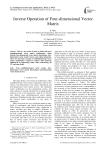
Inverse Operation of Four-dimensional Vector Matrix
Статья научная
This is a new series of study to define and prove multidimensional vector matrix mathematics, which includes four-dimensional vector matrix determinant, four-dimensional vector matrix inverse and related properties. There are innovative concepts of multi-dimensional vector matrix mathematics created by authors with numerous applications in engineering, math, video conferencing, 3D TV, and other fields.
Бесплатно
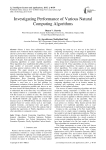
Investigating Performance of Various Natural Computing Algorithms
Статья научная
Nature is there since millenniums. Natural elements have withstood harsh complexities since years and have proved their efficiency in tackling them. This aspect has inspired many researchers to design algorithms based on phenomena in the natural world since the last couple of decades. Such algorithms are known as natural computing algorithms or nature inspired algorithms. These algorithms have established their ability to solve a large number of real-world complex problems by providing optimal solutions within the reasonable time duration. This paper presents an investigation by assessing the performance of some of the well-known natural computing algorithms with their variations. These algorithms include Genetic Algorithms, Ant Colony Optimization, River Formation Dynamics, Firefly Algorithm and Cuckoo Search. The Traveling Salesman Problem is used here as a test bed problem for performance evaluation of these algorithms. It is a kind of combinatorial optimization problem and known as one the most famous NP-Hard problems. It is simple and easy to understand, but at the same time, very difficult to find the optimal solution in a reasonable time – particularly with the increase in a number of cities. The source code for the above natural computing algorithms is developed in MATLAB R2015b and applied on several TSP instances given in TSPLIB library. Results obtained are analyzed based on various criteria such as tour length, required iterations, convergence time and quality of solutions. Conclusions derived from this analysis help to establish the superiority of Firefly Algorithms over the other algorithms in comparative terms.
Бесплатно
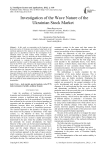
Investigation of the Wave Nature of the Ukrainian Stock Market
Статья научная
In this work we concentrate on the long-term and short term cycles of Ukrainian stock market, being based on the nonlinear approach of the analysis of open systems. First, the paper gives an algorithmic model for the investigation of the nonlinear nature of stock market, which comprises five individual stages. Then, by analyzing the Hurst coefficient for the PFTS index for the Ukrainian stock market it is shown that it is persistent, i.e. contains the fractals. As the results, a parabolic function is used for the approximation of a nonlinear trend in the PFTS series. Moreover, the major tendency of the PFTS index gives the correlation trends of “blue chips”. The elimination of trends and the usage of Fourier analysis allow one to determine the long-term and short-term cycles in the index and shares. Finally, by investigating the weight of the long-term harmonics in the cyclic component of the PFTS index, the stability of Ukrainian stock market is studied in a short-time period. The application of the results involves the forecasting of the crisis points of stock market and proves the effectiveness of shareholders
Бесплатно
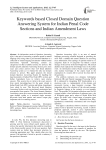
Статья научная
In information retrieval, Question Answering (QA) is the task of answering a question posed in natural language (NL) using either a pre-structured database or a collection of natural language documents without human intervention. Question Answering systems are categorized on their available resource for answers. The domain specific Question Answering System gives more exact and correct answers than web based Question Answering system as it is limited for only one domain resource to answer. This paper proposes the closed domain Question Answering System for handling the legal documents of Indian Penal Code (IPC) sections and Indian Amendment Laws to retrieve more precise answers. This system tries to retrieve the exact answers from stored knowledge-base for the query related to Indian Penal Code (IPC) sections and Indian Amendment Laws asked by user. This Keyword based Question Answering System works on structured, unstructured and non-question form queries. The closed domain Question Answering system gives more accurate answer than other open domain system as it restricted single resource. Keywords from both queries and answer corpus play important role for extracting answer.
Бесплатно
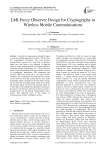
LMI Fuzzy Observer Design for Cryptography in Wireless Mobile Communications
Статья научная
Recently the engineering community began to seek the possibly application of chaos. The fact that the cryptographic community had used discrete pseudo-chaotic systems for a long time to generate cipher keys that leads to the initiation of applying chaos to secure communications. This paper presents a schematic design methodology for a fuzzy observer based secure communication of hyper chaotic systems in cryptographic applications. The transmitter and receiver, which are based on a 3D hyper chaotic oscillator, are synchronized by exploiting the concept on the observer from the control theory. The scalar transmitted signal is designed so that the hyper chaotic carrier masks the encrypted signal, which in turn hides the message signal. To encrypt the message signal, an n-shirt cipher with multiple key algorithms is proposed. In receiver side, the fuzzy observer of chaotic system is designed based on the general Takagi-Sugeno fuzzy model. This approach leads to the design of communication systems with higher security.
Бесплатно
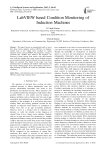
LabVIEW based Condition Monitoring of Induction Machines
Статья научная
This paper focuses on experimental results to prove that motor current signature analysis (MCSA) can diagnose shorted turns in low voltage stator windings of 3-phase induction motors using LabVIEW. The diagnostic strategy is presented and variables that influence the diagnosis are discussed. Current spectra from motors with short-circuited turns (with and without short circuit current limiting resistors) are presented and fully analyzed. Results from motors tested to failure are reported. The results in this paper were from industrial motors of different pole numbers with concentric and lap wound winding designs. Since stator failures account for a high percentage of failures the results are particularly relevant to industry.
Бесплатно
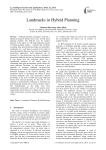
Статья научная
Although planning techniques achieved a significant progress during recent years, solving many planning problem still difficult even for modern planners. In this paper, we will adopt landmark concept to hybrid planning setting - a method that combines reasoning about procedural knowledge and causalities. Landmarks are a well-known concept in the realm of classical planning. Recently, they have been adapted to hierarchical approaches. Such landmarks can be extracted in a pre-processing step from a declarative hierarchical planning domain and problem description. It was shown how this technique allows for a considerable reduction of the search space by eliminating futile plan development options before the actual planning. Therefore, we will present a new approach to integrate landmark pre-processing technique in the context of hierarchical planning with landmark technique in the classical planning. This integration allows to incorporate the ability of using extracted landmark tasks from hierarchical domain knowledge in the form of HTN and using landmark literals from classical planning. To this end, we will construct a transformation technique to transform the hybrid planning domain into a classical domain model. The methodologies in this paper have been implemented successfully, and we will present some experimental results that give evidence for the consid-erable performance increase gained through planning system.
Бесплатно
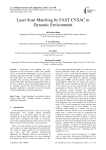
Laser Scan Matching by FAST CVSAC in Dynamic Environment
Статья научная
Localization and mapping are very important for safe movement of robots. One possible way to assist with this functionality is to use laser scan matching. This paper describes a method to implement this functionality. It is based on well-known random sampling and consensus (RANSAC) and iterative closest point (ICP). The proposed algorithm belongs to the class of point to point scan matching approach with its matching criteria rule. The performance of the proposed algorithm is examined in real environment and found applicable in real-time application.
Бесплатно
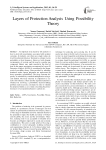
Layers of Protection Analysis Using Possibility Theory
Статья научная
An important issue faced by risk analysts is how to deal with uncertainties associated with accident scenarios. In industry, one often uses single values de-rived from historical data or literature to estimate events probability or their frequency. However, both dynamic environments of systems and the need to consider rare component failures may make unrealistic this kind of data. In this paper, uncertainty encountered in Layers Of Protection Analysis (LOPA) is considered in the framework of possibility theory. Data provided by reliability databases and/or experts judgments are represented by fuzzy quantities (possibilities). The fuzzy outcome frequency is calculated by extended multiplication using α-cuts method. The fuzzy outcome is compared to a scenario risk tolerance criteria and the required reduction is obtained by resolving a possibilistic decision-making problem under necessity constraint. In order to validate the proposed model, a case study concerning the protection layers of an operational heater is carried out.
Бесплатно
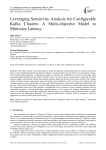
Статья научная
This article presents a new multi-objective model that optimizes Kafka configuration to minimize end-to-end latency while quantifying independent parameter influence, interaction effects and sensitivity to local parameter changes. The proposed model addresses a challenging problem of selecting the configuration to prevent overloading while maintaining high availability and low latency of Kafka cluster. The study proposes an algorithm to implement this model using an adaptive optimization strategy that combines gradient-based and derivative-free search methods. This strategy enables a balance between convergence speed and global search capabilities, which is critical when dealing with the nonlinear parameter space characteristic of large-scale Kafka deployments. Experimental evaluation demonstrates 99% accuracy of the model verified against a trained XGBRegressor model and tested across multiple optimization strategies. The experimental results show that alternative configurations can be selected to meet secondary objectives-such as operational constraints - without significantly impacting latency. In this context, the designed multi-objective model serves as a valuable tool to guide the configuration selection process by quantifying and incorporating such secondary objectives into the optimization landscape. The proposed multi-objective function could be adopted in real time applications as a tool for Kafka performance tuning.
Бесплатно
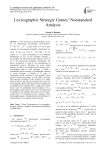
Lexicographic Strategic Games' Nonstandard Analysis
Статья научная
A new concept of a mixed strategy is given for m-dimensional lexicographic noncooperative Γ(Γ^0,Γ^1,...,Γ^(m-1)) game when on a set of pure strategies m-dimensional probability distributions are given. In this case each Γ^k(k=0,1,...,m-1) criteria of Γ game corresponds to its probability distributions on sets of pure strategies. Besides, a lexicographic m-dimensional order relation is given on set of -dimensional probability distribution. The given construction is made by the methodology of nonstandard analysis Therefore, the given mixed strategy is called a nonstandard mixed strategy, and a lexicographic game in such strategies is called a nonstandard mixed extension. An equilibrium situation in mixed strategies is defined in Γ game. A nonstandard mixed extension of lexicographic matrix games is studied thoroughly. In such games, necessary and sufficient conditions of the existence of a saddle point are proved. The analyzed examples show that if in a lexicographic matrix game doesn’t exist a saddle point in standard mixed strategies then a saddle point maybe doesn’t exist in nonstandard mixed strategies. If in a lexicographic matrix game doesn’t exist a saddle point in standard mixed strategies then there can be existed a saddle point in nonstandard mixed strategies. Thus, lexicographic games’ nonstandard mixed distribution is a generalization of a standard mixed extension.
Бесплатно
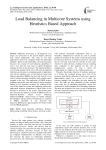
Load balancing in multicore systems using heuristics based approach
Статья научная
Multicore processing is advantageous over single core processors in the present highly advanced time critical applications. The tasks in real time applications need to be completed within the prescribed deadlines. Based on this philosophy, the proposed paper discusses the concept of load balancing algorithms in such a way that the work load is equally distributed amongst all cores in the processor. The equal distribution of work load amongst all the cores will result in enhanced utilization and increase in computing speed of application with all the deadlines met. In the heuristic based load balanced algorithm (HBLB), the best task from the set of tasks is selected using the feasibility check window and is assigned to the core. The application of HBLB reduces imbalance among the cores and results in lesser migration leading to low migration overhead. By utilizing all the cores of the multicore system, the computing speed of the application increases tremendously which results in the increase in efficiency of the system. The present paper also discusses the improved version of HBLB, known as Improved_Heuristic Based Load Balancing (Improved_HBLB), which focuses on further reducing the imbalance and the number of backtracks as compared to HBLB algorithm. It was observed that Improved_HBLB gives approximately 10% better results over the HBLB algorithm.
Бесплатно
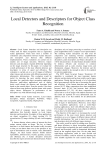
Local Detectors and Descriptors for Object Class Recognition
Статья научная
Local feature detection and description are widely used for object recognition such as augmented reality applications. There have been a number of evaluations and comparisons between feature detectors and descriptors and between their different implementations. Those evaluations are carried out on random sets of image structures. However, feature detectors and descriptors respond differently depending on the image structure. In this paper, we evaluate the overall performance of the most efficient detectors and descriptors in terms of speed and efficiency. The evaluation is carried out on a set of images of different object classes and structures with different geometric and photometric deformations. This evaluation would be useful for detecting the most suitable detector and descriptor for a particular object recognition application. Moreover, multi-object applications such as digilog books could change the detector and descriptor used based on the current object. From the results, it has been observed that some detectors perform better with certain object classes. Differences in performance of the descriptors vary with different image structures.
Бесплатно
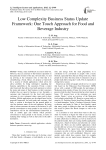
Low Complexity Business Status Update Framework: One Touch Approach for Food and Beverage Industry
Статья научная
Today, many individuals are used to dine-out. However, they are unaware of the business operation on that particular moment of the day. Several times, we end up arriving at the restaurant only to find that it is closed/having a break. Hence, we propose a framework for a system of related applications which solves the above problem by being informative regarding the business operability to the customers. Firstly, a trader side framework that allows food stall operators to inform the status and nature of their business to their customers whether they are open for business or not. Secondly, a customer side framework for the food stall operator customers to view restaurant status, menu and to place booking. Mobile applications are developed based on the proposed framework for both trader and customer. And lastly, a website is developed for the general public to view the business status of the stall operators. By being able to inform customers the status of the business, it will provide convenience to many people in our society. Our contribution will be the aforementioned framework as well as mobile apps and website which provides convenience to many people in our society, in terms of reducing time wastage as well as fuel costs to the stall's destination.
Бесплатно

Статья научная
This paper presents the design of low noise amplifier (LNA) at 2.45 GHz and integrated at 0.18 µm RF CMOS process technology. This type of LNA at 2.45 GHz is use in the Bluetooth receiver. The proposed method is useful to optimize noise performance and power gain while maintaining good input and output matching. The amplifier is designed to be used as first stage of a receiver for wireless communication. The main aim of designer is to achieve low noise figure with improved gain with the help of CMOS technology by using single stage n-MOS amplifier. The simulation results show a forward gain of 14.0 dB, a noise-figure of 0.5 dB and stability factor is approximate unity, in which the circuit operates at 14.2 mA drain current with supply voltage of 3.5 V and biasing voltage of 1.5 V.
Бесплатно
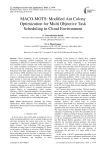
MACO-MOTS: modified ant colony optimization for multi objective task scheduling in cloud environment
Статья научная
Cloud computing is the development of distributed computing, parallel computing, and grid computing, or defined as a commercial implementation of such computer science concepts. One of the main issues in a cloud computing environment is Task scheduling (TS). In Cloud task scheduling, many Non deterministic Polynomial time-hard optimization problem, and many meta-heuristic (MH) algorithms have been proposed to solve it. A task scheduler should adapt its scheduling strategy to changing environment and variable tasks. This paper amends a cloud task scheduling policy based on Modified Ant Colony Optimization (MACO) algorithm. The main contribution of recommended method is to minimize makespan and to perform Multi Objective Task Scheduling (MOTS) process by assigning pheromone amount relative to corresponding virtual machine efficiency. MACO algorithm improves the performance of task scheduling by reducing makespan and degree of imbalance comparatively lower than a basic ACO algorithm by its multi-objective and deliberate nature.
Бесплатно
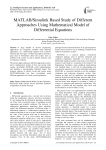
Статья научная
A large number of diverse engineering applications are frequently modeled using different approaches, viz., a differential equation or by a transfer function and state space. All these descriptions provide a great deal of information about the system, such as stability of the system, its step or impulse response, and its frequency response. The present paper addresses different approaches used to derive mathematical models of first and second order system, developing MATLAB script implementation and building a corresponding Simulink model. The dynamic analysis of electric circuit and system using MATLAB/Simulink has been investigated using different approaches for chosen system parameters..
Бесплатно

MCS-MCMC for Optimising Architectures and Weights of Higher Order Neural Networks
Статья научная
The standard method to train the Higher Order Neural Networks (HONN) is the well-known Backpropagation (BP) algorithm. Yet, the current BP algorithm has several limitations including easily stuck into local minima, particularly when dealing with highly non-linear problems and utilise computationally intensive training algorithms. The current BP algorithm is also relying heavily on the initial weight values and other parameters picked. Therefore, in an attempt to overcome the BP drawbacks, we investigate a method called Modified Cuckoo Search-Markov chain Monté Carlo for optimising the weights in HONN and boost the learning process. This method, which lies in the Swarm Intelligence area, is notably successful in optimisation task. We compared the performance with several HONN-based network models and standard Multilayer Perceptron on four (4) time series datasets: Temperature, Ozone, Gold Close Price and Bitcoin Closing Price from various repositories. Simulation results indicate that this swarm-based algorithm outperformed or at least at par with the network models with current BP algorithm in terms of lower error rate.
Бесплатно

MMeMeR: An Algorithm for Clustering Heterogeneous Data using Rough Set Theory
Статья научная
In recent times enumerable number of clustering algorithms have been developed whose main function is to make sets of objects having almost the same features. But due to the presence of categorical data values, these algorithms face a challenge in their implementation. Also some algorithms which are able to take care of categorical data are not able to process uncertainty in the values and so have stability issues. Thus handling categorical data along with uncertainty has been made necessary owing to such difficulties. So, in 2007 MMR algorithm was developed which was based on basic rough set theory. MMeR was proposed in 2009 which surpassed the results of MMR in taking care of categorical data and it could also handle heterogeneous values as well. SDR and SSDR were postulated in 2011 which were able to handle hybrid data. These two showed more accuracy when compared to MMR and MMeR. In this paper, we further make improvements and conceptualize an algorithm, which we call MMeMeR or Min-Mean-Mean-Roughness. It takes care of uncertainty and also handles heterogeneous data. Standard data sets have been used to gauge its effectiveness over the other methods.
Бесплатно
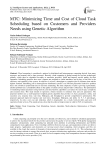
Статья научная
Cloud computing is considered a pattern for distributed and heterogeneous computing derived from many resources, and requests aim to share resources. Recently, cloud computing is graded among the top best technologies globally, which must be scheduled favorably to maximize providers’ profit and improve service quality for their customers. Scheduling specifies how users’ requests are assigned to virtual machines, and it plays a vital role in the efficiency and capability of the system. Its objective is to have a throughput or complete jobs in minimum time and the highest standard. Scheduling jobs in heterogeneous distributed systems is an NP-hard polynomial indecisive problem that is not solvable in polynomial time for real-time scheduling. The time complexity of jobs is growing exponentially, and this problem has a considerable effect on the quality of cloud services and providers’ efficiencies. The optimization of scheduling-related parameters using heuristic and meta-heuristic algorithms can reduce the search space complexity and execution time. This study intends to represent a fitness function to minimize time and cost parameters. The proposed method uses a multi-purposed weighted genetic algorithm that provides six basic parameters: utility, task execution cost, response time, wait time, Makespan, and throughput to provide comprehensive optimization. The proposed approach improved response and wait times, throughput, Makespan, and utility 16, 9, 7, 8 percentages, respectively, by only a one cost unit reduction, which is dispensable. As a result, both providers and users will experience better services. The statistical tests show that the achieved improvement is valid for 94% of experiments.
Бесплатно

